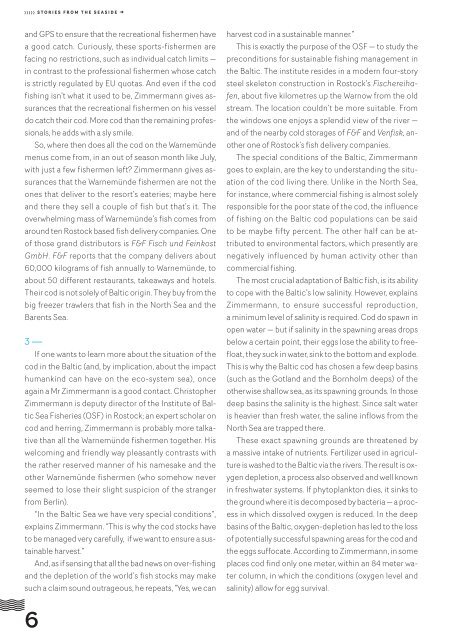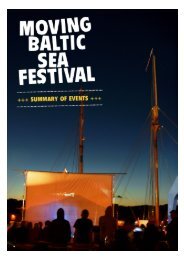the plotki magazine (pdf) - Moving Baltic Sea
the plotki magazine (pdf) - Moving Baltic Sea
the plotki magazine (pdf) - Moving Baltic Sea
You also want an ePaper? Increase the reach of your titles
YUMPU automatically turns print PDFs into web optimized ePapers that Google loves.
S T O R I E S F R O M T H E S E A S I D E →and GPS to ensure that <strong>the</strong> recreational fishermen havea good catch. Curiously, <strong>the</strong>se sports-fishermen arefacing no restrictions, such as individual catch limits in contrast to <strong>the</strong> professional fishermen whose catchis strictly regulated by EU quotas. And even if <strong>the</strong> codfishing isn’t what it used to be, Zimmermann gives assurancesthat <strong>the</strong> recreational fishermen on his vesseldo catch <strong>the</strong>ir cod. More cod than <strong>the</strong> remaining professionals,he adds with a sly smile.So, where <strong>the</strong>n does all <strong>the</strong> cod on <strong>the</strong> Warnemündemenus come from, in an out of season month like July,with just a few fishermen left? Zimmermann gives assurancesthat <strong>the</strong> Warnemünde fishermen are not <strong>the</strong>ones that deliver to <strong>the</strong> resort’s eateries; maybe hereand <strong>the</strong>re <strong>the</strong>y sell a couple of fish but that’s it. Theoverwhelming mass of Warnemünde’s fish comes fromaround ten Rostock based fish delivery companies. Oneof those grand distributors is F&F Fisch und FeinkostGmbH. F&F reports that <strong>the</strong> company delivers about60,000 kilograms of fish annually to Warnemünde, toabout 50 different restaurants, takeaways and hotels.Their cod is not solely of <strong>Baltic</strong> origin. They buy from <strong>the</strong>big freezer trawlers that fish in <strong>the</strong> North <strong>Sea</strong> and <strong>the</strong>Barents <strong>Sea</strong>.3 ―If one wants to learn more about <strong>the</strong> situation of <strong>the</strong>cod in <strong>the</strong> <strong>Baltic</strong> (and, by implication, about <strong>the</strong> impacthumankind can have on <strong>the</strong> eco-system sea), onceagain a Mr Zimmermann is a good contact. ChristopherZimmermann is deputy director of <strong>the</strong> Institute of <strong>Baltic</strong><strong>Sea</strong> Fisheries (OSF) in Rostock; an expert scholar oncod and herring, Zimmermann is probably more talkativethan all <strong>the</strong> Warnemünde fishermen toge<strong>the</strong>r. Hiswelcoming and friendly way pleasantly contrasts with<strong>the</strong> ra<strong>the</strong>r reserved manner of his namesake and <strong>the</strong>o<strong>the</strong>r Warnemünde fishermen (who somehow neverseemed to lose <strong>the</strong>ir slight suspicion of <strong>the</strong> strangerfrom Berlin).“In <strong>the</strong> <strong>Baltic</strong> <strong>Sea</strong> we have very special conditions”,explains Zimmermann. “This is why <strong>the</strong> cod stocks haveto be managed very carefully, if we want to ensure a sustainableharvest.”And, as if sensing that all <strong>the</strong> bad news on over-fishingand <strong>the</strong> depletion of <strong>the</strong> world’s fish stocks may makesuch a claim sound outrageous, he repeats, “Yes, we canharvest cod in a sustainable manner.”This is exactly <strong>the</strong> purpose of <strong>the</strong> OSF to study <strong>the</strong>preconditions for sustainable fishing management in<strong>the</strong> <strong>Baltic</strong>. The institute resides in a modern four-storysteel skeleton construction in Rostock’s Fischereihafen,about five kilometres up <strong>the</strong> Warnow from <strong>the</strong> oldstream. The location couldn’t be more suitable. From<strong>the</strong> windows one enjoys a splendid view of <strong>the</strong> river and of <strong>the</strong> nearby cold storages of F&F and Venfisk, ano<strong>the</strong>rone of Rostock’s fish delivery companies.The special conditions of <strong>the</strong> <strong>Baltic</strong>, Zimmermanngoes to explain, are <strong>the</strong> key to understanding <strong>the</strong> situationof <strong>the</strong> cod living <strong>the</strong>re. Unlike in <strong>the</strong> North <strong>Sea</strong>,for instance, where commercial fishing is almost solelyresponsible for <strong>the</strong> poor state of <strong>the</strong> cod, <strong>the</strong> influenceof fishing on <strong>the</strong> <strong>Baltic</strong> cod populations can be saidto be maybe fifty percent. The o<strong>the</strong>r half can be attributedto environmental factors, which presently arenegatively influenced by human activity o<strong>the</strong>r thancommercial fishing.The most crucial adaptation of <strong>Baltic</strong> fish, is its abilityto cope with <strong>the</strong> <strong>Baltic</strong>’s low salinity. However, explainsZimmermann, to ensure successful reproduction,a minimum level of salinity is required. Cod do spawn inopen water but if salinity in <strong>the</strong> spawning areas dropsbelow a certain point, <strong>the</strong>ir eggs lose <strong>the</strong> ability to freefloat,<strong>the</strong>y suck in water, sink to <strong>the</strong> bottom and explode.This is why <strong>the</strong> <strong>Baltic</strong> cod has chosen a few deep basins(such as <strong>the</strong> Gotland and <strong>the</strong> Bornholm deeps) of <strong>the</strong>o<strong>the</strong>rwise shallow sea, as its spawning grounds. In thosedeep basins <strong>the</strong> salinity is <strong>the</strong> highest. Since salt wateris heavier than fresh water, <strong>the</strong> saline inflows from <strong>the</strong>North <strong>Sea</strong> are trapped <strong>the</strong>re.These exact spawning grounds are threatened bya massive intake of nutrients. Fertilizer used in agricultureis washed to <strong>the</strong> <strong>Baltic</strong> via <strong>the</strong> rivers. The result is oxygendepletion, a process also observed and well knownin freshwater systems. If phytoplankton dies, it sinks to<strong>the</strong> ground where it is decomposed by bacteria a processin which dissolved oxygen is reduced. In <strong>the</strong> deepbasins of <strong>the</strong> <strong>Baltic</strong>, oxygen-depletion has led to <strong>the</strong> lossof potentially successful spawning areas for <strong>the</strong> cod and<strong>the</strong> eggs suffocate. According to Zimmermann, in someplaces cod find only one meter, within an 84 meter watercolumn, in which <strong>the</strong> conditions (oxygen level andsalinity) allow for egg survival.6



